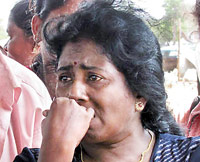Let us follow in Mary’s footsteps and bring hope to the hopeless
We thank God for giving us another opportunity to prepare ourselves for the coming of Christ. In Sri Lanka we are living in the post-war experience, where people are waiting for hope.

Let us follow in Mary’s footsteps and bring hope to the hopeless
The Tamil community in particular is waiting for economic, political and social freedom.It is against this background that I would like to focus on the spirituality of Mary, and how she prepared herself to meet the historical Jesus in her life.
As you know, Mary became pregnant by the Holy Spirit. For this reason she was isolated from her husband, as well as by society. So she was going through a lot of emotional agony and mental depression.
In the midst of all this, she went to Judah to meet and share her pain with another woman, Elizabeth (Luke 1: 39-45). When she got there, she realised that Elizabeth also was going through a similar experience.
Both shared their painful experiences with one another. They didn’t find the answer to their problems, but the sharing of their experiences brought them some sort of empowerment and relief in their struggle.
In our Sri Lankan context, women are the people who carry the heaviest burden. There are so many women who are widows in Sri Lanka.
They are waiting for a person who will come and listen to their cry. Listening and sharing can bring hope into a hopeless situation. Therefore, at this special Advent time, we need to become listeners in order to give hope to other people.
The Gospel of Luke (Chapter 1:42-52) speaks about the Passover feast. When Jesus was 12, he went to Jerusalem for this feast. On their way home his parents realised that he was not with them.
Mary started to search among the friends and relatives, but it was only after three days that she found him, in the Temple. In the Sri Lankan context, women are searching for their husbands, sons and daughters.
They go to the police station, they go to the human rights office, they go here and there, searching for those who are missing – Mary, as the mother of Jesus, had gone through this experience of searching for her child.
Finally, she found him in the Temple. Our mothers, even though they are searching day and night, are unable to find their sons and daughters.
Therefore, Mary identifies herself with the searching community in Sri Lanka. That spirituality gives hope to the people who are searching for their sons and daughters.
When Jesus was hanging on the cross he urged his mother to accept John as her son. At the same time he asked John to accept Mary as his mother (John 19:25-27).
When we read this passage, we can see that John represents the Jerusalem tradition, and people with a rich background. On the other hand Mary represents poor families and the Galilean tradition.
Therefore, Jesus asks both of them to go beyond their traditions and see the “otherness” of others. Mary was ready to accept John as her child.
In the same way John was ready to accept poor Mary as his mother. In the Sri Lankan context, so many children have lost their fathers and/or mothers; they are crying for hope.
Are we ready to accept them as our children? Mary is the stepping stone and she prepares the way for us to follow her methodology of accepting John as her son.
Are we ready to practise this spirituality of accepting others as our brothers and sisters in order to give them hope?
This Advent, help us to revisit the spirituality of Mary, following in her footsteps and bringing hope to the hopeless by sharing and identifying and accepting the pain of another as our own pain.
Let us ask God to help us by giving us his strength and courage to become hope-givers.


